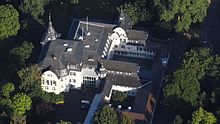Wilhelm Ludwig Deichmann
Wilhelm Ludwig Deichmann (born August 3, 1798 in Rodenberg / Deister, † November 23, 1876 in Bonn-Mehlem ) was a German banker .
Life
Deichmann, the third son of a Hessian civil servant, married one of the daughters of the Cologne banker Abraham Schaaffhausen , who died in 1824, on May 26, 1830 , Elisabeth Jacobine Eleonore "Lilla" Schaaffhausen . Through this marriage, in the same year 1830, he became head and partner of the leading trading and banking house A. Schaaffhausen'scher Bankverein in Cologne . The integration of Deichmann into the wealthy family served after the death of his father-in-law and the early retirement of his two sons from business life to quickly fill vacant positions in the bank. The family and family relationships, especially at Cologne banks, were complex. In the years between 1821 and 1907, eleven direct marital connections were made within the main tribes of the Herstatt, Deichmann, Stein and Schnitzler families. The Deichmann family bought a baroque palace near Bonn as a summer residence (today: Schloss Deichmannsaue ), which soon became a meeting place for society. On September 1, 1853, Johannes Brahms, who was just 20 years old, visited the Deichmann family there. Deichmann retained the position as banker of the Schaaffhausen'sche Bank after its consolidation until autumn 1857. Wilhelm Ludwig Deichmann died on November 23, 1876 and was buried in Cologne in the Melaten cemetery ( Millions Avenue ).
Own bank

Deichmann then co-founded the Cologne bank "Deichmann & Co.", which resided in Trankgasse , in 1857 together with Adolph vom Rath . His brother Adolf Deichmann (1811–1882) had already built a bank of the same name in Amsterdam in 1842. The bank in Cologne developed steadily through entry into industrial finance and strengthened Cologne's banking system . Deichmann & Co. became one of the founding banks of today's Deutsche Bank AG in 1870 , because co-owner Adolph vom Rath, as a representative of his house, was a member of the founding committee of Deutsche Bank and was a member of the board of directors, which on February 25, 1870, the founding statute of the Prussian government submitted. Like all Cologne banks, the bank took part in industrial financing and was also internationally successful when it helped the Belgian arms factory Établissements Pieper SA (owned by the Westphalian Heinrich Pieper) to reorganize, which was in financial difficulties . In 1862 it played a key role in building the locomotive builder " Oscar Henschel & Sohn ". After the death of their father, the sons Theodor (1837–1895), Otto (1838–1911) and Wilhelm (1841–1919) continued to run the bank. The eldest son Adolf Deichmann (1831–1907) was a banker in London and could not take care of the German banking business. In 1913, a seven-storey office and commercial building for the bank - now in the hands of Karl-Theodor and Arthur Deichmann - (henceforth known as the “ Deichmannhaus ”) with a shell limestone facade (architect: Heinrich Müller-Erkelenz ) was built in Trankgasse . Today there are several small shops and a large Gaffel Kölsch brewery on the ground floor. In 1927, the bank was represented in the Klöckner loan consortium as part of industrial finance. On September 24, 1931, the bank files for bankruptcy due to the general global economic crisis.
literature
- Franz Brill : Deichmann, Wilhelm Ludwig. In: New German Biography (NDB). Volume 3, Duncker & Humblot, Berlin 1957, ISBN 3-428-00184-2 , p. 567 f. ( Digitized version ).
Web links
Individual evidence
- ^ Ingo Köhler: Economic Citizens and Entrepreneurs - On the Marriage Behavior of German Private Bankers in the Transition to the 20th Century. In: Dieter Ziegler (Ed.): Upper citizens and entrepreneurs. The German business elite in the 20th century (= studies on civil society. 17). Vandenhoeck & Ruprecht, Göttingen 2000, ISBN 3-525-35682-X , pp. 116–143, here p. 126, ( limited preview in the Google book search).
- ^ Rainer Liedtke: On the patronage practice and on the cultural self-image of the Jewish business elite in Germany: The Hamburg Warburgs in the first third of the 20th century. In: Dieter Ziegler (Ed.): Upper citizens and entrepreneurs. The German business elite in the 20th century (= studies on civil society. 17). Vandenhoeck & Ruprecht, Göttingen 2000, ISBN 3-525-35682-X , pp. 187–203, here pp. 200 f.
- ↑ Stadtmuseum Bonn ( Memento of the original dated November 24, 2009 in the Internet Archive ) Info: The archive link was inserted automatically and has not yet been checked. Please check the original and archive link according to the instructions and then remove this notice.
- ↑ Josef Abt, Johann Ralf Beines: Melaten. Cologne graves and history. Photos Celia Körber-Leupold. Greven, Cologne 1997, ISBN 3-7743-0305-3 , p. 170.
- ^ Wilhelm Treue : Private banking in the 19th century. In: Helmut Coing , Walter Wilhelm (Ed.): Science and Codification of Private Law in the 19th Century. Volume 5: Money and Banks (= Studies on Law of the Nineteenth Century. 5). Klostermann, Frankfurt am Main 1980, ISBN 3-465-01332-8 , pp. 94–127, here p. 102, ( limited preview in the Google book search).
- ^ HS Merseburg, reports on the economy
| personal data | |
|---|---|
| SURNAME | Deichmann, Wilhelm Ludwig |
| BRIEF DESCRIPTION | German entrepreneur, Cologne banker |
| DATE OF BIRTH | August 3, 1798 |
| PLACE OF BIRTH | Rodenberg |
| DATE OF DEATH | November 23, 1876 |
| Place of death | Bonn-Mehlem |


